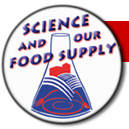 |
 |
||
| The A to Z | 2007 Edition |
|
|
|
List of Terms: D
The temperature range in which most bacteria can grow. Food Safety Implication: Some bacteria can double their numbers within minutes and form toxins that cause illness within hours. That's why it's important to keep food below or above the temperatures at which bacteria can grow. Usually this is below 40° F (4° C) (some pathogenic bacteria can grow at 32° F [0° C] or above 140° F [60° C]). Food Safety Precautions:
Note: For more about handling foods safely, see the 4 Cs section.
> Deoxyribonucleic Acid (DNA)
Food Safety Implication: In bacteria, the DNA molecule encodes the information for factors that enable it to grow, reproduce, and confer virulence (ability to cause illness). Each organism's DNA can be used to distinguish it from related organisms. When there is an outbreak of foodborne illness, epidemiologists can determine the source of bacteria in foods by examining the pathogen's DNA "fingerprint." The Fabulous Five The discovery of the double-helical structure of DNA began in 1951. The 5 people responsible for its discovery were:
> Disinfectant (see Sanitizer) |
Food Safety A to Z Reference Guide
Hypertext updated by dms/dav 2008-JUL-02